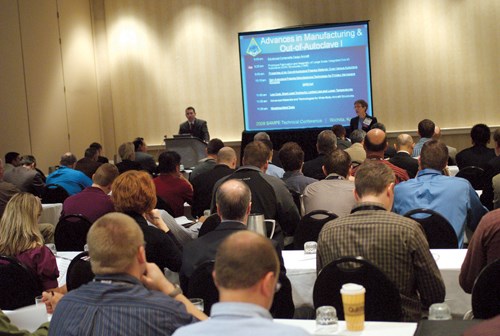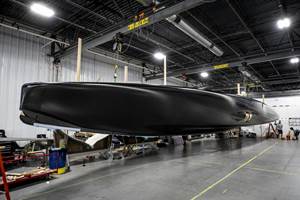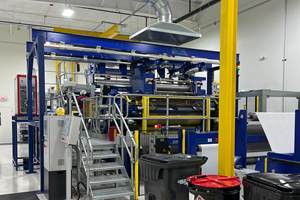Wichita welcomes SAMPE Tech
The Society’s Fall Conference flourishes in one of the epicenters of U.S. aerospace activity.
The Society for the Advancement of Material and Process Engineering’s (SAMPE) 2009 Fall Technical Conference & Exhibition, held in Wichita, Kan., in late October 2009, belied the economic downturn, attracting a record number of exhibitors and visitors alike. The Century II Convention Center space was filled to capacity, and a wide range of interesting and relevant papers were on offer.
Two keynote speakers anchored the event. The first, John Pilla, senior VP and general manager of the propulsion segment at Wichita-based Spirit Aerosystems, spoke about “Global Materials Technology.” He believes the drivers for new materials are 1) environmental protection, 2) fuel cost, 3) the growth in air travel and 4) maintenance improvement. While he sees the benefits of composites, he also noted some of the challenges, which include delamination, high cost of materials and processing and temperature resistance, among others. Nevertheless, innovation and new technology development are critical and, he says, the effort will be global. The second keynoter, Persis Elwood, division chief of the materials and manufacturing directorate at Wright Patterson AFB, described how globalization already has impacted the defense industry. She outlined many of the programs in which composite materials play a role, and stressed that in order for materials and processes to deliver their potential, manufacturing readiness must be considered earlier than ever before in the development cycle. She called for more effective partnering between customers and suppliers.
A number of interactive panel discussions were on the program, focused on key areas, such as benchmarking of composite technology for aircraft and marine structures (U.S. vs. Europe); damage resistance of composite sandwich structures; energy issues in aviation; demonstrations of design and analysis tools; technologies to assist composite manufacturers; a roundtable discussion of polyhedral oligomeric silsesquioxanes (POSS); and a workshop panel hosted by the Air Force Office of Scientific Research (AFOSR). CompositesWorld’s technical editor Sara Black chaired a panel entitled “Commercializing Composites: The Outlook for High-Volume, Sustainable Material Applications.” Panelists included John Busel, director of the Composites Growth Initiative with the American Composites Manufacturers Assn. (ACMA, Arlington, Va.), Chris Red of Composite Market Reports (Gilbert, Ariz.), Andre Cocquyt of GRP Guru (Brunswick, Maine) and Paul Oldroyd, senior manager of Manufacturing Research & Technology at Bell Helicopter Textron (Ft. Worth, Texas). The presentations focused on high-volume composites applications in a number of market areas, including wind, marine, civil engineering and commercial aerospace. Panelists pointed out the barriers to wider acceptance of commercial composites, and identified promising avenues for increasing composites usage, such as reductions in material and process cost and ways to push aerospace technology down to consumers of more everyday products. All the panelists agreed that inspection is a key factor that will enhance acceptance. Government policy will play a role, said Cocquyt, citing the need to work with regulators. Oldroyd stressed that bulk processing methods will unlock high-volume applications, and that some disruptive technologies are on the way, including perhaps some nanotechnologies.
The subject of nanotechnology was raised throughout the conference. Several sessions were solely devoted to the topic. Of note was a paper presented by Richard Liang of Florida State University College of Engineering (Tallahassee, Fla.), High Performance Materials Institute (HPMI), entitled “Highly Electrical Conductive Multi-Walled Carbon Nanotube/BMI Composites.” Liang described how his team creates buckypaper, then stretches the material to align the carbon nanotube (CNT) fibers. The stretched material is prepregged with bismaleimide (BMI) resin to create a composite with outstanding properties, including high tensile properties, high strain capability and electrical conductivity.
On the exhibition floor, standouts included a new polyaryl ether amide resin system from Evonik Degussa Corp. (Parsippany, N.J.), with a high glass transition temperature (Tg), and greater toughness and higher flame/smoke/toxicity (FST) performance than standard epoxy with comparable compression and shear performance. Based on a phenolic backbone and reminiscent of the PEAR resins of the 1990s, the new one-part resin, trademarked CALIDUR, is formaldehyde-free, offers long-term storage stability at ambient temperature, and, according to Evonik, can deliver significant improvements over aerospace epoxies in high-performance aerospace laminates, at a competitive cost.
Magnolia Plastics Inc. (Chamblee, Ga.) showcased its epoxy line, including adhesives, syntactics and resins for tooling, repair and general-purpose applications. On display were Magnobond 7590 A/B, a two-component epoxy resin/adhesive with high temperature resistance and a long out time that can be cured at 250° to 300°F (121° to 149°C) for one to three hours. The product is typically used with dry glass or carbon fiber in a wet layup for composite structural repair. A second product, Magnobond 6335, is a lower viscosity, faster-setting version of Magnobond 7590 A/B. Magnobond 6800 A/B is a flame retardant, two-component epoxy laminating system that is designed to meet the requirements of Sikorsky Specification SS 9460, Type I, for aerospace composites repair, and another product — Magnobond 6168-1 — is offered specifically for rotor blade repair. The company revealed that it was part of a delegation of Georgia aerospace companies and manufacturers that would attend the Dubai Air Show in Dubai, a few weeks after the SAMPE Tech event, to exhibit its aerospace resin expertise.
P²SI (Performance Polymer Solutions, Inc., Moraine, Ohio) took First Place honors for Best Technical Paper at the conference, which discussed the company’s trademarked 900HT composite prepreg system with a glass transition temperature of 900°F/482°C. The easily processed material, which is a hybrid inorganic/organic thermosetting resin, is based on poly(imide siloxane) chemistry. The group is targeting high-temperature composite tooling that can withstand the process temperatures required to mold polyimide- and bismaleimide-based composite parts.
Matrix Composites Inc. (Rockledge, Fla.) highlighted its expertise as a supplier to Lockheed Martin (Los Angeles, Calif.), specifically related to resin transfer molding (RTM) of aerospace parts. The company emphasized that it is branching out into new areas, with upcoming projects that include fabrication of nacelle parts for a major propulsion OEM, and development of new, next-generation tooling concepts in partnership with a leading tooling manufacturer.
Lokeren, Belgium-based Acrosoma (formerly Composittrailer), announced its new name and its expanded focus, which will include market areas outside of transportation trailers. The company highlighted a recent application of its composite panels: Continuously fabricated using the company’s panel pultrusion process, they form a series of box beams to create a composite transport frame for a large aircraft wing. At 33m/108 ft in length and 9m/29 ft wide, the frame is designed with the same features and appearance as a similar steel transport frame, but weighs considerably less, at only 3.5 metric tonnes (7,700 lb).
A2 Technologies (Danbury, Conn.) exhibited its new Exoscan handheld sensing device, based on FTIR (Fourier transform infrared) sensing technology. Capable of detecting chemical changes, such as thermal damage, for nondestructive testing, or NDT, the device has a “diffuse reflectance sample interface,” which reportedly enables it to achieve results even if the surface does not reflect light well and/or has a rough texture.
Exova (Anaheim, Calif.), formerly Orange County Materials Test Laboratories, exhibited its comprehensive material testing capabilities for a variety of industries, including aerospace composites. The Anaheim facility is one of 13 testing locations in the U.S. available for composite material testing services.
Specialty Materials Inc. (Lowell, Mass.) was on hand to exhibit its longstanding chemical vapor deposited boron fiber and silicon carbide fiber products, as well as its carbon monofilament product. The carbon pitch-based monofilament, normally used as the substrate for the company’s manufacture of its SCS silicon carbide fibers, was recently made available as a separate product. With a fiber diameter of 33 µm, it is significantly larger than typical carbon fibers (5 to 10 µm) and, therefore, can be handled differently in new applications that could exploit the fiber’s electrical properties, says the company.
Solid Concepts (Valencia, Calif.) exhibited its range of powdered materials used for rapid prototyping/additive manufacturing. A relatively new product is a carbon fiber-filled polyamide resin that has been successfully used for complex-shaped engine parts (see the "Applications" piece on this new product, which appeared in this issue, by clicking on the link in “Editor's Picks,” at right).
Ticona (Florence, Ky.) showcased a new application for its Fortron PPS (polyphenylene sulfide) thermoplastic resin as a matrix in a unidirectional carbon fiber prepreg, which is subsequently braided by A&P Technology Inc. (Cincinnati, Ohio) and manufactured into an aircraft seat frame by Cutting Dynamics Inc. (Avon, Ohio). The material meets all flame/smoke/toxicity (FST) requirements for aircraft interiors. Currently in the certification process for more than one customer, the frame’s much lower weight means substantial fuel cost savings for airlines, and ease of processing results in a lower part cost, reports Ticona. The company is pursuing other structural aerospace applications for carbon fiber-reinforced PPS, including rudders and elevators.
Related Content
Pro-Set named official materials supplier for New York Yacht Club American Magic
Competitive sailing team prepares for the 37th America’s Cup beginning in August 2024 with adhesives, resins and laminate testing services for its AC75 monohull construction.
Read MoreFilm adhesive enables high-temperature bonding
CAMX 2024: Aeroadhere FAE-350-1, Park Aerospace’s curing modified epoxy, offers high toughness with elevated temperature performance when used in primary and secondary aerospace structures.
Read MoreBiDebA project supports bio-based adhesives development for composites
Five European project partners are to engineer novel bio-based adhesives, derived from renewable resources, to facilitate composites debonding, circularity in transportation markets.
Read MorePark Aerospace launches aerospace, MRO structural film adhesive
Aeroadhere FAE-350-1 is a curing epoxy formulation designed for composite, metal, honeycomb and hybrid applications.
Read MoreRead Next
Developing bonded composite repair for ships, offshore units
Bureau Veritas and industry partners issue guidelines and pave the way for certification via StrengthBond Offshore project.
Read MoreVIDEO: High-volume processing for fiberglass components
Cannon Ergos, a company specializing in high-ton presses and equipment for composites fabrication and plastics processing, displayed automotive and industrial components at CAMX 2024.
Read MoreAll-recycled, needle-punched nonwoven CFRP slashes carbon footprint of Formula 2 seat
Dallara and Tenowo collaborate to produce a race-ready Formula 2 seat using recycled carbon fiber, reducing CO2 emissions by 97.5% compared to virgin materials.
Read More
























